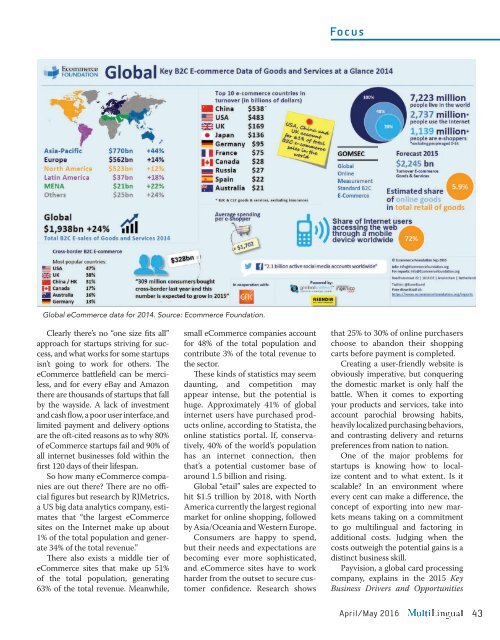Localization
z99kl79
z99kl79
You also want an ePaper? Increase the reach of your titles
YUMPU automatically turns print PDFs into web optimized ePapers that Google loves.
Focus<br />
Global eCommerce data for 2014. Source: Ecommerce Foundation.<br />
Clearly there’s no “one size fits all”<br />
approach for startups striving for success,<br />
and what works for some startups<br />
isn’t going to work for others. The<br />
eCommerce battlefield can be merciless,<br />
and for every eBay and Amazon<br />
there are thousands of startups that fall<br />
by the wayside. A lack of investment<br />
and cash flow, a poor user interface, and<br />
limited payment and delivery options<br />
are the oft-cited reasons as to why 80%<br />
of eCommerce startups fail and 90% of<br />
all internet businesses fold within the<br />
first 120 days of their lifespan.<br />
So how many eCommerce companies<br />
are out there? There are no official<br />
figures but research by RJMetrics,<br />
a US big data analytics company, estimates<br />
that “the largest eCommerce<br />
sites on the Internet make up about<br />
1% of the total population and generate<br />
34% of the total revenue.”<br />
There also exists a middle tier of<br />
eCommerce sites that make up 51%<br />
of the total population, generating<br />
63% of the total revenue. Meanwhile,<br />
small eCommerce companies account<br />
for 48% of the total population and<br />
contribute 3% of the total revenue to<br />
the sector.<br />
These kinds of statistics may seem<br />
daunting, and competition may<br />
appear intense, but the potential is<br />
huge. Approximately 41% of global<br />
internet users have purchased products<br />
online, according to Statista, the<br />
online statistics portal. If, conservatively,<br />
40% of the world’s population<br />
has an internet connection, then<br />
that’s a potential customer base of<br />
around 1.5 billion and rising.<br />
Global “etail” sales are expected to<br />
hit $1.5 trillion by 2018, with North<br />
America currently the largest regional<br />
market for online shopping, followed<br />
by Asia/Oceania and Western Europe.<br />
Consumers are happy to spend,<br />
but their needs and expectations are<br />
becoming ever more sophisticated,<br />
and eCommerce sites have to work<br />
harder from the outset to secure customer<br />
confidence. Research shows<br />
that 25% to 30% of online purchasers<br />
choose to abandon their shopping<br />
carts before payment is completed.<br />
Creating a user-friendly website is<br />
obviously imperative, but conquering<br />
the domestic market is only half the<br />
battle. When it comes to exporting<br />
your products and services, take into<br />
account parochial browsing habits,<br />
heavily localized purchasing behaviors,<br />
and contrasting delivery and returns<br />
preferences from nation to nation.<br />
One of the major problems for<br />
startups is knowing how to localize<br />
content and to what extent. Is it<br />
scalable? In an environment where<br />
every cent can make a difference, the<br />
concept of exporting into new markets<br />
means taking on a commitment<br />
to go multilingual and factoring in<br />
additional costs. Judging when the<br />
costs outweigh the potential gains is a<br />
distinct business skill.<br />
Payvision, a global card processing<br />
company, explains in the 2015 Key<br />
Business Drivers and Opportunities<br />
April/May 2016 43


